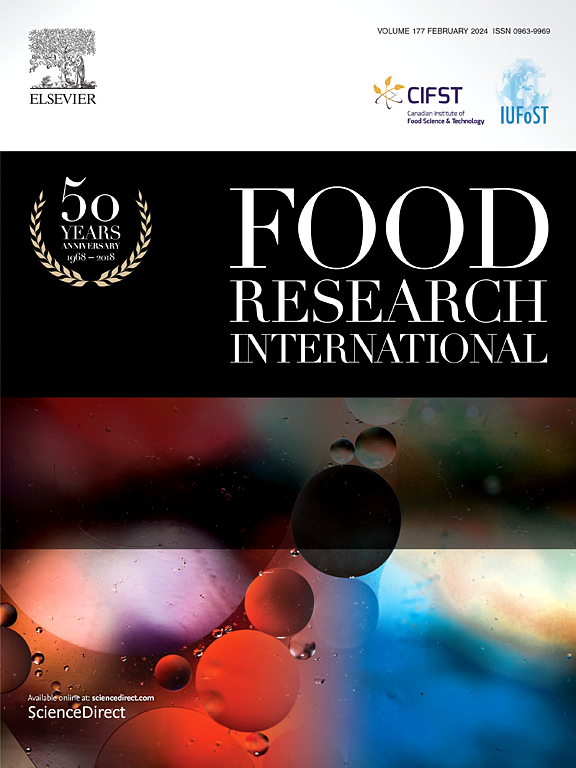Enhanced freeze-drying efficiency in restructured peach: Multiscale insights into heat and mass transfer mechanisms from experiments and computational simulations
IF 7
1区 农林科学
Q1 FOOD SCIENCE & TECHNOLOGY
引用次数: 0
Abstract
While restructuring agricultural products enhances heat and mass transfer during freeze-drying, the underlying mechanisms remain poorly understood. This study employed a multiscale approach, combining freezing dynamics, sublimation drying kinetics, X-ray tomography, gas permeability assessments, thermodynamic parameters analysis, and mathematical modeling to systematically investigate the differences in transfer properties between natural and restructured peaches across the freezing and sublimation drying processes. Key results demonstrated that restructuring decreased the freezing time by 21.30 min–26.70 min and the sublimation time by 24 h–32 h, achieving an overall time reduction of 25.27 %–33.73 % compared to natural peaches. Microstructural analysis showed that restructuring significantly modified pore architecture, resulting in increased average pore size, overall porosity, open porosity, pore connectivity, specific surface area, and gas permeability, while simultaneously reducing closed porosity and relative apparent density. Thermodynamic characterization further revealed that restructuring not only reduced the heat capacity but also enhanced the thermal conductivity of peaches across the freezing and sublimation drying stages. The developed model successfully predicted experimental parameters and provided visualizations of the temporal evolution of the solidification and sublimation fronts, along with vapor velocity, temperature, and pressure distributions. Particularly noteworthy was the observation that restructured peaches exhibited lower pressure at the interface and accelerated movement of the sublimation front during the sublimation stage. These findings collectively demonstrate that restructuring significantly improved the heat and mass transfer characteristics of peaches during freezing and sublimation, enabling a more energy-efficient and environmentally friendly freeze-drying process with promising industrial applications.

重组桃的冻干效率提高:从实验和计算模拟中对传热传质机制的多尺度见解
虽然重组农产品在冷冻干燥过程中增强了热量和质量传递,但其潜在机制仍然知之甚少。本研究采用多尺度方法,结合冷冻动力学、升华干燥动力学、x射线断层扫描、透气性评估、热力学参数分析和数学建模,系统研究了天然桃子和重组桃子在冷冻和升华干燥过程中转移特性的差异。关键结果表明,重组处理使冷冻时间缩短了21.30 min ~ 26.70 min,升华时间缩短了24 h ~ 32 h,与天然桃子相比,总时间缩短了25.27% ~ 33.73%。微观结构分析表明,重组显著改变了孔隙结构,增加了平均孔径、总孔隙度、开放孔隙度、孔隙连通性、比表面积和渗透率,同时降低了封闭孔隙度和相对表观密度。热力学表征进一步表明,重构不仅降低了桃子在冷冻和升华干燥阶段的热容,而且提高了热导率。该模型成功地预测了实验参数,并提供了凝固和升华锋面的时间演变,以及蒸汽速度、温度和压力分布的可视化。特别值得注意的是,在升华阶段,重组后的桃子在界面处表现出较低的压力和升华锋的加速运动。这些研究结果共同表明,重组显著改善了桃子在冷冻和升华过程中的传热传质特性,使其成为一种更节能、更环保的冷冻干燥工艺,具有广阔的工业应用前景。
本文章由计算机程序翻译,如有差异,请以英文原文为准。
求助全文
约1分钟内获得全文
求助全文
来源期刊

Food Research International
工程技术-食品科技
CiteScore
12.50
自引率
7.40%
发文量
1183
审稿时长
79 days
期刊介绍:
Food Research International serves as a rapid dissemination platform for significant and impactful research in food science, technology, engineering, and nutrition. The journal focuses on publishing novel, high-quality, and high-impact review papers, original research papers, and letters to the editors across various disciplines in the science and technology of food. Additionally, it follows a policy of publishing special issues on topical and emergent subjects in food research or related areas. Selected, peer-reviewed papers from scientific meetings, workshops, and conferences on the science, technology, and engineering of foods are also featured in special issues.
 求助内容:
求助内容: 应助结果提醒方式:
应助结果提醒方式:


